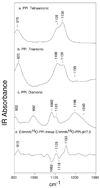Pyrophosphate activation in hypoxanthine--guanine phosphoribosyltransferase with transition state analogue
- PMID: 20170081
- PMCID: PMC2851198
- DOI: 10.1021/bi100012u
Pyrophosphate activation in hypoxanthine--guanine phosphoribosyltransferase with transition state analogue
Abstract
Isotope-edited difference Raman and FTIR studies complemented by ab initio calculations have been applied to the transition state analogue complex of HGPRT.ImmHP.MgPP(i) to determine the ionic states of the 5'-phosphate moiety of ImmHP and of PP(i). These measurements characterize electrostatic interactions within the enzyme active site as deduced from frequency shifts of the phosphate groups. The bound 5'-phosphate moiety of ImmHP is dianionic, and this phosphate group exists in two different conformations within the protein complex. In one conformation, a hydrogen bond between the 5'-phosphate of ImmHP and the OH group of Tyr104 in the catalytic loop appears to be stronger. With the stronger H-bond, the OH of Tyr104 approaches one of the P..O bonds from the bridging oxygen side to cause distortion of the PO(3) moiety, as indicated by a lowered symmetric P..O stretch frequency. The asymmetric stretch frequencies are similar in both phosphate conformations. Bound PP(i) in this complex is fully ionized to P(2)O(7)(4-). Bond frequency changes for bound PP(i) indicate coordination to Mg(2+) ions but show no indication of significant P..O bond polarization. Extrapolation of these results to reaction coordinate motion for HGPRT suggests that bond formation between C1' of the nucleotide ribose and the oxygen of PP(i) is accomplished by migration of the ribocation toward immobilized pyrophosphate.
Figures







Similar articles
-
Enzyme active site interactions by Raman/FTIR, NMR, and ab initio calculations.Adv Protein Chem Struct Biol. 2013;93:153-82. doi: 10.1016/B978-0-12-416596-0.00005-1. Adv Protein Chem Struct Biol. 2013. PMID: 24018325 Free PMC article. Review.
-
Ionic states of substrates and transition state analogues at the catalytic sites of N-ribosyltransferases.Biochemistry. 2003 May 20;42(19):5694-705. doi: 10.1021/bi034003a. Biochemistry. 2003. PMID: 12741826
-
Crystal structure of Toxoplasma gondii hypoxanthine-guanine phosphoribosyltransferase with XMP, pyrophosphate, and two Mg(2+) ions bound: insights into the catalytic mechanism.Biochemistry. 1999 Nov 2;38(44):14495-506. doi: 10.1021/bi990508i. Biochemistry. 1999. PMID: 10545171
-
Leaving group activation and pyrophosphate ionic state at the catalytic site of Plasmodium falciparum orotate phosphoribosyltransferase.J Am Chem Soc. 2010 Dec 1;132(47):17023-31. doi: 10.1021/ja107806j. Epub 2010 Nov 10. J Am Chem Soc. 2010. PMID: 21067187 Free PMC article.
-
Hypoxanthine-guanine phosphoribosyltransferase as a therapeutic target in protozoal infections.Infect Agents Dis. 1995 Mar;4(1):29-40. Infect Agents Dis. 1995. PMID: 7728354 Review.
Cited by
-
Distortional binding of transition state analogs to human purine nucleoside phosphorylase probed by magic angle spinning solid-state NMR.Proc Natl Acad Sci U S A. 2013 Oct 1;110(40):15991-6. doi: 10.1073/pnas.1313657110. Epub 2013 Sep 16. Proc Natl Acad Sci U S A. 2013. PMID: 24043827 Free PMC article.
-
Isotope-edited FTIR of alkaline phosphatase resolves paradoxical ligand binding properties and suggests a role for ground-state destabilization.J Am Chem Soc. 2011 Aug 3;133(30):11621-31. doi: 10.1021/ja203370b. Epub 2011 Jul 13. J Am Chem Soc. 2011. PMID: 21692505 Free PMC article.
-
Enzyme active site interactions by Raman/FTIR, NMR, and ab initio calculations.Adv Protein Chem Struct Biol. 2013;93:153-82. doi: 10.1016/B978-0-12-416596-0.00005-1. Adv Protein Chem Struct Biol. 2013. PMID: 24018325 Free PMC article. Review.
-
Periodontal Disease Monitoring by Raman Spectroscopy of Phosphates: New Insights into Pyrophosphate Activity.Diagnostics (Basel). 2023 Dec 27;14(1):66. doi: 10.3390/diagnostics14010066. Diagnostics (Basel). 2023. PMID: 38201375 Free PMC article.
-
Raman Spectroscopy: In Vivo Application for Bone Evaluation in Oral Reconstructive (Regenerative) Surgery.Diagnostics (Basel). 2022 Mar 16;12(3):723. doi: 10.3390/diagnostics12030723. Diagnostics (Basel). 2022. PMID: 35328277 Free PMC article.
References
-
- Xu Y, Eads J, Sacchettini JC, Grubmeyer C. Kinetic mechanism of human hypoxanthine-guanine phosphoribosyltransferase: rapid phosphoribosyl transfer chemistry. Biochemistry. 1997;36:3700–3712. - PubMed
-
- Ullman B, Carter D. Hypoxanthine-guanine phosphoribosyltransferase as a therapeutic target in protozoal infections. Infectious Agents & Disease. 1995;4:29–40. - PubMed
-
- Wang CC. Parasite enzymes as potential targets for antiparasitic chemotherapy. Journal of Medicinal Chemistry. 1984;27:1–9. - PubMed
-
- Freymann DM, Wenck MA, Engel JC, Feng J, Focia PJ, Eakin AE, Craig SP. Efficient identification of inhibitors targeting the closed active site conformation of the HPRT from Trypanosoma cruzi. Chem Biol. 2000;7:957–968. - PubMed
-
- Sculley DG, Dawson PA, Emmerson BT, Gordon RB. A review of the molecular basis of hypoxanthine-guanine phosphoribosyltransferase (HPRT) deficiency. Human Genetics. 1992;90:195–207. - PubMed
Publication types
MeSH terms
Substances
Grants and funding
LinkOut - more resources
Full Text Sources
Miscellaneous

